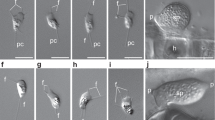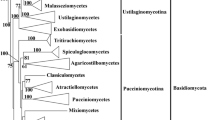Abstract
Small subunit rRNA gene sequences (18S rDNA), cell wall carbohydrate composition and ubiquinone components were analysed within a larger number of ascomycetous yeasts and dimorphic fungi to validate their congruence in predicting phylogenetic relationships. The glucose-mannose pattern distinguishes the Hemiascomycetes from the Euascomycetes and the Protomycetes which are characterised with the glucose-mannose-galactose-rhamnose-(fucose) profile. The glucose-mannose-galactose pattern was found in the cell walls of all the three classes. Different coenzyme Q component (CoQ5 to CoQ10) were found within the representatives of the Hemiascomycetes. Whereas CoQ9, CoQ10 and CoQ10H2 predominate within the Euascomycetes, CoQ9 and CoQ10 characterise the Protomycetes. Chemotaxonomic studies coupled with additional molecular and co-evolution studies support the idea that the Hemiascomycetes occupy a basal position in the phylogeny of Ascomycota. These results are not in line with the phylogenetic studies based on the sequences of 18S rRNA encoding gene. The maximum parsimony analysis indicated that Hemiascomycetes and Protomycetes might represent sister groups, opposing to the earlier reported results, where the Archiascomycetes (Protomycetes) or the Hemiascomycetes had been considered to be the most primitive ascomycetous fungi. Instead of the class Archiascomycetes, the term Protomycetes was introduced reflecting much better the properties of the whole class.
Similar content being viewed by others

References
Alexopoulos CJ, Mims CW, Blackwell M (1996) Phylum Chytridiomycota. In Introductory Mycology, 4th edition, pp. 86–126. Wiley, New York.
Ahrazem O, Gómez-Miranda B, Prieto A, Barasoaín I, Bernabé M, Leal A (2000) An acidic water-soluble cell wall polysaccharide: a chemotaxonomic marker for Fusarium and Gibberella. — Mycological Research 104: 603–610.
Barr M E (2001) Ascomycota. In Esser K, Lemke PA (eds.) The Mycota: Systematics and Evolution VII, Part A. pp. 161–177. Springer, Berlin, Heidelberg, New York.
Berbee ML, Taylor JW (1993) Dating the evolutionary radiations of the true fungi. — Canadian Journal of Botany 71: 1114–1127.
Berbee M L, Taylor JW (2001) Fungal molecular evolution: gene trees and geologic time. In Esser K, Lemke PA (eds.) The Mycota: Systematics and Evolution VII, Part B. pp. 229–245. Springer, Berlin, Heidelberg, New York.
Byers B, Goetsch L (1975) Electronic microscopic observations on the meiotic karyotype of diploid and tetraploid Saccharomyces cervisiae. — Proceedings of the National Academy of Sciences USA. 72: 5056–5069.
Cai J, Roberts IN, Collins MD (1996) Phylogenetic relationships among members of the ascomycetous yeast genera Brettanomyces, Debaryomyces, Dekkera, and Kluyveromyces deduced by small-subunit rRNA gene sequences. — International Journal of Systematic Bacteriology 46: 542–549.
Clarke L, Baum MP (1990) Functional analysis of a centromere from fission yeast: a role for centromere-specific repeated DNA sequences. — Molecular and Cellular Biology 10: 1863–1872.
Eriksson OE (2001) SSU rDNA sequences from Ascomycota. — Myconet 6: 27–74.
Goffeau A, Barell BG, Bussey H, Davis RW, Dujon B, Feldman H, Galibert F, Hoheisel JD, Jacq C, Johnston M, Louis EJ, Mewes HW, Murakami Y, Philippsen P, Tettelin H, Oliver SG (1996) Life with 6000 genes. — Science 274: 574–567.
Gottschalk M, Blanz PA (1985) Untersuchungen an 5S ribosomalen Ribonucleinsäuren als Beitrag zur Klärung von Systematik und Phylogenie der Basidiomyceten. — Zeitschrift für Mykologie 51: 205–243.
Hoheisel JD, Maier E, Mott R, McCarthy L, Gregoriev AV, Schalkwyk LC, Nizetic D, Francis F, Lehrach H (1993) High resolution cosmid and P1 maps spanning the 14 Mb genome of the fission yeast S. pombe. — Cell 73: 109–120.
Kurtzman CP (1993) Systematics of the ascomycetous yeasts assessed from ribosomal RNA sequence divergence. — Antonie van Leeuwenhoek. 63: 165–174.
Kurtzman CP, Sugiyama J (2001) Ascomycetous Yeasts and Yeastlike Taxa. In Esser K, Lemke PA (eds.) The Mycota: Systematics and Evolution VII, Part A, pp. 179–200. Springer, Berlin, Heidelberg, New York.
Leal AJ, Bernabé M (1998) Taxonomic applications of polysaccharides. In Frisvad JC, Bridge PD, Arora DK (eds.) Chemical Fungal Taxonomy, pp. 153–181. Marcel Dekker, New York, Basel, Hongkong.
Liu Y, Whelen S, Hall B (1999) Phylogenetic relationships among ascomycetes: evidence from an RNA Polymerase II Subunit. — Molecular Biology and Evolution 16: 1799–1808.
Lopandic K, Prillinger H, Molnár O, Giménez-Jurado G (1996) Molecular characterization and genotypic identification of Metschnikowia species. — Systematic and Applied Microbiology 19: 393–402.
Lumbsch HT, Wirtz N, Lindemuth R, Schmitt I (2002) Combined analysis of nuclear and mitochondrial sequence data improves resolution of major clades in filamentous ascomycetes. — Mycological Progress 1: 57–70.
Messner R, Prillinger H, Altmann F, Lopandic K, Wimmer K, Molnár O, Weigang F (1994) Molecular characterisation and application of random amplified polymorphic DNA analysis of Mrakia and Sterigmatomyces species. — International Journal of Systematic Bacteriology 44: 694–703.
Mewes HW, Albermann K, Bähr M, Frishman D, Gleissner A, Hani J, Heuman K, Kleine K, Maierl A, Oliver SG, Pfeifer F, Zollner A (1997a) Overview of the yeast genome. — Nature 387: 7–65.
Mewes HW, Albermann K, Heuman K, Liebl S, Pfeifer F (1997b) MIPS: a database for protein sequences, homology data and yeast genome information. — Nucleic Acids Research 35: 28–30.
Moore TDE, Edman JC (1993) The a-mating type locus of Cryptococcus neoformans contains a peptide pheromone gene. — Molecular and Cellular Biology 13: 1962–1970.
Müller E (1977) Systemfragen bei Ascomyceten. In Frey W, Hurka H, Oberwinkler F (eds) Beiträge zur Biologie der niederen Pflanzen, pp. 43–57. Gustav Fischer Verlag, Stuttgart, New York.
Nishida H, Sugiyama J (1994) Archiascomycetes: detection of a major new lineage within the Ascomycota. — Mycoscience 35: 361–366.
O’Brien RW, Ralph BJ (1966) The cell wall composition and taxonomy of some Basidiomycetes and Ascomycetes. — Annals of Botany, N.S. 30: 831–843.
Prillinger H (1984) Zur Evolution von Mitose, Meiose und Kernphasenwechsel bei Chitinpilzen. — Zeitschrift für Mykologie 50: 267–352.
Prillinger H (1987) Yeasts and anastomoses: their occurrence and implications for the phylogeny of Eumycota. In Rayner ADM, Brasier CM, Moore D (eds.) Evolutionary biology of the fungi, pp. 355–377. Cambridge University Press, Cambridge.
Prillinger H, Deml G, Dörfler C, Laaser G, Lockau W (1991a) Ein Beitrag zur Systematik und Entwicklungsbiologie Höherer Pilze: Hefe-Typen der Basidiomyceten. Teil II: Microbotryum-Typ. — Botanica Acta 104: 5–17.
Prillinger H, Dörfler C, Laaser G, Eckerlein B, Lehle L (1990a) Ein Beitrag zur Systematik und Entwicklungsbiologie Höherer Pilze: Hefe-Typen der Basidiomyceten. Teil I: Schizosaccharomycetales, Protomyces-Typ. — Zeitschrift für Mykologie 56: 219–250.
Prillinger H, Dörfler C, Laaser G, Hauska G (1990b) Ein Beitrag zur Systematik und Entwicklungsbiologie Höherer Pilze: Hefe-Typen der Basidiomyceten. Teil III: Ustilago-Typ. — Zeitschrift für Mykologie 56: 251–278.
Prillinger H, Laaser G, Dörfler C, Ziegler K (1991b) Ein Beitrag zur Systematik und Entwicklungsbiologie Höherer Pilze: Hefe-Typen der Basidiomyceten. Teil IV: Dacrymyces-Typ, Tremella-Typ. — Sydowia 53: 170–218.
Prillinger H, Lopandic K, Schweigkofler W, Deak R, Aarts HJM, Bauer R, Sterflinger K, Kraus GF, Maraz A (2002) Phylogeny and systematics of the fungi with special reference to the Ascomycota and Basidiomycota. — In Breitenbach M., Crameri R., Lehrer SB (eds.) Fungal Allergy and Pathogenicity. Chemical Immunology 81: 207–295. Karger, Basel.
Prillinger H, Messner R, König H, Bauer R, Lopandic K, Molnár O, Dangel P, Weigang F, Kirisits T, Nakase T, Sigler L (1996) Yeasts associated with termites: a phenotypic and genotypic characterisation and use of coevolution for dating evolutionary radiations in asco-and basidiomycetes. — Systematic and Applied Microbiology 19: 265–283.
Prillinger H, Oberwinkler F, Umile C, Tlachac K, Bauer R, Dörfler C, Taufratzhofer E (1993) Analysis of cell wall carbohydrates (neutral sugars) from ascomycetous and basidiomycetous yeasts with and without derivatisation. — Journal of General and Applied Microbiology 39: 1–34.
Prillinger H, Schweigkofler W, Breitenbach M, Briza P, Staudacher E, Lopandic K, Molnár O, Weigang F, Ibl M, Ellinger A (1997) Phytopathogenic filamentous (Ashbya, Eremothecium) and dimorphic fungi (Holleya, Nematospora) with needle-shaped ascospores as new members within the Saccharomycetaceae. — Yeast 13: 945–960.
Savile DB (1955). A phylogeny of the Basidiomycetes. — Canadian Journal of Botany 33: 60–104.
Savile DB (1968) Possible interrelationships between fungal groups. In Ainsworth GC, Suss-Man AS (eds) The Fungi, pp. 649–675. Academic Press, New York, London.
Schweigkofler W, Lopandic K, Molnár O, Prillinger H (2002) Analysis of phylogenetic relationships among Ascomycota with yeast phases using ribosomal DNA sequences and cell wall sugars. — Organisms, Diversity & Evolution 2: 1–17.
Spatafora JW (1995) Ascomal evolution of filamentous ascomycetes: evidence from molecular data. — Canadian Journal of Botany (Suppl. 1) 73: S811–S815.
Spencer JFT, Phaff HP, Gardner NR (1964) Metschnikowia kamienskii, sp. n., a yeast associated with brine shrimp. — Journal of Bacteriology 88: 758–762.
Swofford DL (2002) PAUP*, Phylogenetic Analysis Using Parsimony (*and other Methods). Version 4. Sinauer Associates, Sounderland, Massachusetts.
Thompson JD, Gibson TJ, Plewniak F, Jeanmougin F, Higgins DG (1997) The ClustalX windows interface: flexible strategies for multiple sequence alignments aided by quality analysis tools. — Nucleic Acids Research 24: 4874–4882.
Voigt K, Wöstemeyer J (2001) Phylogeny and origin of 82 zygomycetes from all 54 genera of the Mucorales and Mortierellales based on combined analysis of actin and translation elongation factor EF-1a genes. — Gene 270: 113–120.
Walossek D (1995) The Upper Cambrian Rehbachiella, its larval development, morphology and significance for the phylogeny of Branchiopoda and Crustacea. — Hydrobiologia 298: 1–13.
Weijman ACM, De Hoog GS (1975) On the subdivision of the genus Ceratocystis. — Antonie van Leeuvenhoek 41: 353–360.
Yarrow D (1998) Methods for the isolation, maintenance and identification of yeasts. In Kurtzman CP, Fell JW (eds) The Yeasts, a Taxonomic Study, 4th edn, pp. 854–872. Elsevier Science B.V: Amsterdam.
Author information
Authors and Affiliations
Corresponding author
Rights and permissions
About this article
Cite this article
Lopandic, K., Molnár, O., Suzuki, M. et al. Estimation of phylogenetic relationships within the Ascomycota on the basis of 18S rDNA sequences and chemotaxonomy. Mycol Progress 4, 205–214 (2005). https://doi.org/10.1007/s11557-006-0124-6
Accepted:
Issue Date:
DOI: https://doi.org/10.1007/s11557-006-0124-6



